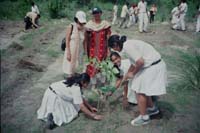|
Tree Plantation by
CLEAN-Delhi
- Breathing new life into
the city T he importance of trees in purifying the air, as natural resources, maintaining the ecological balance, preventing soil erosion, as medicines, habitats for faunal species, providing nutrients to the soil etc. is well known. The present forest and tree cover in the country according to the State of Forest Report 2001 of the Forest Survey of India is 23.03 per cent. According to the National Forest Policy, the country is required to achieve a forest cover target of 25 per cent by 2007 and 33 per cent cover by 2012. Again, against the National Forest Policy requirement of 33 per cent forest cover in every State, Delhi’s figure is 10.2 per cent.The involvement of people - particularly at the grassroots level - and agencies outside the Government is crucial for achieving these targets. Development Alternatives through its CLEAN-India programme has long been involved in plantation activities across the country.The Delhi Unit of CLEAN-India Programme organised a Tree plantation drive in Delhi in August-October 2004. The drive was conducted in collaboration with the Dept. of Environment, Government of NCT Delhi and agencies like the Forest Deptt., NDMC, MCD & CPWD. About 300 students from CLEAN-Delhi partner schools participated in the drive that saw the plantation of over 1500 trees in various localities of Delhi. "The trees come up to my window like the yearning voice of the dumb earth" - Rabindranath Tagore This year, special care was taken to choose saplings from among the native species like Kachnar, Kanak Champa, Neem, Arjun, Sheesham, Bel, and Peepal. The air, water, soil and climate of the Delhi region are most suitable for the growth of these native species, and hence their survival rate is quite high. In turn, these support the birds, insects and animals of this ecosystem. These species also are most effective in fighting air and noise pollution. The highlight of the drive was the tree plantation at Garhi Mandu on the banks of River Yamuna where over 700 trees were planted. Children showed great enthusiasm in planting these trees which they knew would recharge ground water, prevent soil erosion and prevent siltation of their river. Metal plates with their names written on them were placed under the first sapling planted by each of them. A massive tree plantation drive was also carried out at Asola and Bhatti. In spite of the rocky terrain and hardened soil, children planted hundreds of trees. Forest officials and the Eco task force personnel briefed them about the development of Asola as a wild life sanctuary and reclamation and greening of Bhatti mines.
Prior to each plantation activity, students were briefed about the significance of native trees, how to plant them and their after care. Resource material for the programme was developed in form of brochures giving information about native trees. The brochure, ‘Trees of Delhi’ highlighted the identifying features and uses of native trees with the help of illustrations. At the end of the activity, each student was presented a memento in form of a leaf shaped book-mark, which would act as a reminder of the ennobling task he/she had performed. The students were asked to conduct follow-up activities to see how the saplings they had planted were doing and also submit a report on the activity after a period of three months. All the findings by the students were documented and sent to the Department of Environment in the form of a report. It was however learnt from student observations that in spite of the plantation being done in the monsoon season, most of the roadside saplings could not last for even a month. This was largely due to the absence of prompt installation of tree guards and proper watering. Saplings inside parks and institutional areas however were found to be doing well. Thus, mere planting of trees will not help. Proper care has to be taken of the saplings planted. Following points should be noted while doing tree plantations, anywhere in the country.
The plantation drive by CLEAN-Delhi was thus a perfect example of how grass-root level NGOs, school students and the various government line departments can work in tandem towards a cleaner, greener city. It is hoped that in the coming years, the children not just plant more and more trees but also take care of them, watch them grow and be able bask in their glorious beauty. q" Limit your need, minimize your greed; sow a seed, let the earth breathe"— Karan, CLEAN-Bangalore |

